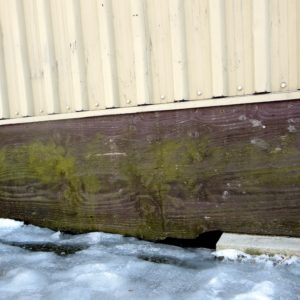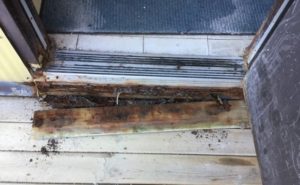Very early in the Fix Our Schools campaign, we realized that portables were excluded from the school disrepair data collected and tracked by our provincial government. The rationale provided by the Province has always been that portables were “temporary structures” and therefore, routine assessment of portable conditions was unnecessary. The exclusion of portables from assessments means that the $16.8-B of disrepair currently plaguing Ontario’s public schools does not even include the disrepair found in portables.
Fix Our Schools disagreed with this rationale, noting that portables often became a rather permanent part of local school infrastructure. Furthermore, some of the most disturbing photos we have received over the 8 years of our campaign have been of deplorable conditions in portables. We continue to advocate that there ought to routine assessments of portables, and that there must be standards of good repair in place for school buildings, 

 schoolyards and portables on school sites. We, of course, also continue to advocate for adequate and stable provincial funding to properly repair and renew not only school buildings but also schoolyards and portables. And finally, Fix Our Schools continues to advocate for a reimagined provincial funding model as a whole.
schoolyards and portables on school sites. We, of course, also continue to advocate for adequate and stable provincial funding to properly repair and renew not only school buildings but also schoolyards and portables. And finally, Fix Our Schools continues to advocate for a reimagined provincial funding model as a whole.
When it comes to planning new school buildings, provincial funding unfortunately only allows a new school to be built that can accommodate the number of students at the school at the time of funding approval by the Province. There is no acknowledgement that a new school building has been approved —due to the many new developments being built near that site— meaning many more students will actually be at the school from the first day it opens. That is why we see brand new school buildings open with many portables already on-site. This is not good planning and makes no sense.
Portables also raise equity issues. Students and education workers who spend their days in portables often have more challenging access to resources such as washrooms, gyms, labs, and libraries that are housed in the main school building.
We think it is safe to say that no family or educator is happy when they are assigned to be in a portable for an academic year, which seems to be an indicator that, intuitively, we all recognize that portables are non-optimum learning environments in most cases.
Interestingly, some academic research is also emerging about portables, We recently received this note from Gus Riveros, Associate Professor at the Faculty of Education at Western University:
“I have recently examined portable classroom use in the 27 largest school boards in the province between 2010 and 2020 and I thought Fix our Schools may be interested in some of my findings. For example, I found that 60% of schools in my sample have had at least one portable classroom between 2010 and 2020, and that a large number of the schools that had portables during this time period, had portables for more than 8 consecutive years (46%). That is, 937 schools in the 27 largest school boards in the province had at least one portable classroom for 8 to 10 years in a row! My analysis demonstrates that portable classrooms are not used as a temporary, but as a permanent solution to enrolment pressures and infrastructure backlogs. Some of the findings from this study are explained in more detail here.“
Riveros’ findings substantiate the need for our provincial government to reimagine the funding model for schools in Ontario, and to develop standards of good repair for not only school buildings and schoolyards but also for portables. As we move towards the June 2 provincial election in Ontario, this is yet one more issue to keep in mind as we head to the polls.
